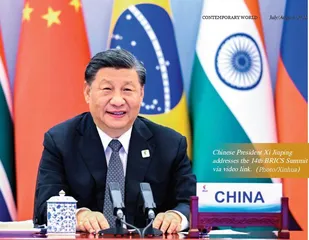BRICS Mechanisms and Global Governance

Fudan Institute of Belt and Road & Global Governance
On June 23, 2022, the 14th BRICS Summit reached new consensuses, and the leaders of the five BRICS countries unanimously agreed on BRICS expansion in line with the “BRICS Plus” cooperation, and discussed pertinent criteria and procedures. As Chinese President Xi Jinping observed, standing at the crossroads of history, we should both look back at the journey we have traveled and keep in mind why we established BRICS in the first place, and look forward to a shared future of a more comprehensive, close, practical and inclusive high-quality partnership to jointly embark on a new journey of BRICS cooperation.
As major developing countries, the BRICS stays committed to promoting gradual reform in global governance, which comes to two aspects namely, advancing the reform of the Bretton Woods system externally, and building the BRICS international organization internally. Such is the basic orientation of BRICS cooperation, as well as the point of departure in considering the current BRICS expansion.
BRICS GRADUAL REFORM ON GLOBAL GOVERNANCE SYSTEM
It is the basic orientation of BRICS cooperation mechanism to advance gradual reform in the global governance system. As BRICS leaders observed at their Fortaleza Summit in July 2014, international governance structures designed within a different power configuration show increasingly evident signs of losing legitimacy and effectiveness, as transitional and ad hoc arrangements become increasingly prevalent, often at the expense of multilateralism. The BRICS countries are an important force in promoting gradual reform on the existing global governance system, committed to achieving a more representative and equitable global governance. At their Beijing Summit, the leaders of the BRICS countries were in total agreement to stay committed to reforming global governance and to making instruments of global governance more inclusive, representative and participatory to facilitate greater and more meaningful participation of developing countries in global decision-making processes and structures and make it better attuned to contemporary realities.
Since the end of the Second World War, the international financial system with the Bretton Woods system at its core had long been controlled by the U.S., Europe and other developed countries. After the international financial crisis of 2008, the BRICS conducted coordination and cooperation with the IMF, the World Bank and the G20, forcefully increasing the influence and say of developing countries in the global governance system. Taking the organizational reform of the IMF for instance, the BRICS countries have spoken with one voice in the discussion on short-term capital control, share structure reform, and new lending arrangements, being a strong counterweight to the U.S. and Europe. A most outstanding case was that the BRICS pushed the IMF to reach a historic plan for quota and governance reforms in 2010.
The BRICS has also helped advance the World Bank’s switch toward better meeting the needs of developing countries. Two problems resided in the World Bank that had long been dominated by developed countries. First, its loan conditions were harsh and rigid. To cater to the preferences of its big shareholders in developed countries, the World Bank had been engaged in promoting liberalization, privatization and democratization reform in developing countries, and imposed it on developing countries as loan conditions. Second, its loan fields had gradually moved away from the needs of developing countries. The World Bank loans were concentrated in such fields as public administration, anti-corruption, gender equality and climate change, neglecting infrastructure like transportation and energy which were more urgently needed in developing countries.
With the joint efforts of the BRICS countries, the World Bank released its Investment Lending Reform: Concept Note, putting forward five concrete reform opinions. First, adopt a risk-based approach to replace one-size-fits-all processes and requirements that apply to investment or project lending (IL); second, consolidate and rationalize the IL menu to respond to clients’ diverse needs including rapid response projects for emergencies and fragile states; third, enhance supervision and implementation support for lending projects; fourth, create enabling environment for IL transformation, and fifth, simplify IL policy framework.
In the reform, the BRICS pushed for the replacement of G8 with G20 as the primary mechanism in global economic governance. To maintain their monopoly of global governance, developed countries had proposed a governance model of “G8+5” namely G8 plus 5 major developing countries. In contrast, the BRICS firmly stood for upholding G20’s core position in global economic governance. In comparison with G8, the advantage of G20 is that it does not draw a line by ideology, that it is balanced in proportion between developed and developing countries, and that its core function is a concert of major powers, thus better attuned to contemporary realities, better accommodating both legitimacy and effectiveness of global governance, and constituting a historic breakthrough in reform on global governance.
In brief, the BRICS are committed to gradual reform on global governance mechanisms, thus being reformers rather than revolutionaries of global governance. The objective of the BRICS cooperation is to push for reform of the global governance system to better reflect legitimate concerns and reasonable interests of most of the countries, particularly developing countries. This basic orientation is also on full display in the BRICS countries creating their own multilateral bodies like the Contingent Reserve Arrangement (CRA) and the New Development Bank (NDB).